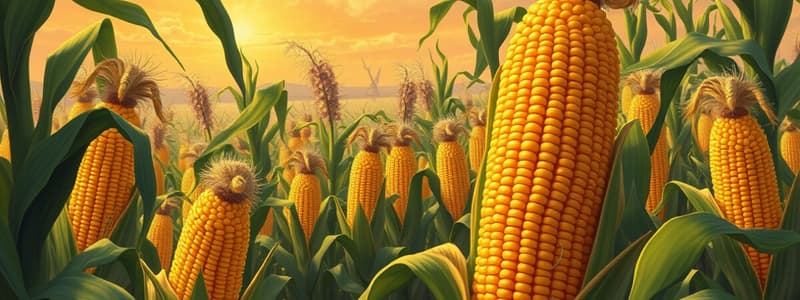Podcast
Questions and Answers
What is the largest crop grown in the United States today?
What is the largest crop grown in the United States today?
- Rice
- Wheat
- Corn (correct)
- Soybeans
What wild grass plant did corn evolve from?
What wild grass plant did corn evolve from?
- Panicum
- Teosinte (correct)
- Zea
- Bromus
Which method did Native Americans use for planting corn, squash, and beans together?
Which method did Native Americans use for planting corn, squash, and beans together?
- Three Sisters method (correct)
- Intercropping
- Companion planting
- Crop rotation
What advantage does corn provide to beans in the Three Sisters method?
What advantage does corn provide to beans in the Three Sisters method?
How did Native Americans improve their corn crop yields?
How did Native Americans improve their corn crop yields?
What role do squash leaves play in the Three Sisters method?
What role do squash leaves play in the Three Sisters method?
Approximately how many years ago did Native Americans begin cultivating corn?
Approximately how many years ago did Native Americans begin cultivating corn?
What nutrient do beans restore to the soil in the Three Sisters planting method?
What nutrient do beans restore to the soil in the Three Sisters planting method?
How many kernels did an ear of teosinte have compared to modern corn?
How many kernels did an ear of teosinte have compared to modern corn?
What did early farmers do with the surplus corn they grew?
What did early farmers do with the surplus corn they grew?
Flashcards are hidden until you start studying
Study Notes
Introduction
- Corn is the largest crop cultivated in the United States, with an annual production value exceeding 60 billion dollars.
- The origins of U.S. corn production trace back over 5,000 years to ancient Mexico.
Early History
- Modern corn, or maize, evolved from a wild grass known as teosinte.
- Native Americans domesticated teosinte in Mexico, transforming it into a crop with a significant increase in kernel count.
- Following its domestication, maize became a staple food for Native American populations across North and South America.
Early Cultivation
- The initial cultivation of corn by Native Americans began more than 5,000 years ago.
- Farmers practiced selective breeding by using seeds from healthier plants to enhance crop yields.
- Surplus corn allowed for the establishment of food reserves, essential for winter sustenance.
- The “Three Sisters” planting method was a key agricultural practice involving corn, squash, and beans.
The 'Three Sisters' Method
- Planting corn, squash, and beans together produced numerous benefits.
- Corn provides vertical support for beans, allowing the latter to climb the stalk.
- Beans enhance soil fertility by fixing nitrogen, improving nutrient availability for crops.
- Squash conserves soil moisture through its wide leaves, benefiting all three plants.
- This symbiotic relationship reflects natural ecosystems, resulting in healthy, diverse crops while preserving soil quality.
Studying That Suits You
Use AI to generate personalized quizzes and flashcards to suit your learning preferences.




